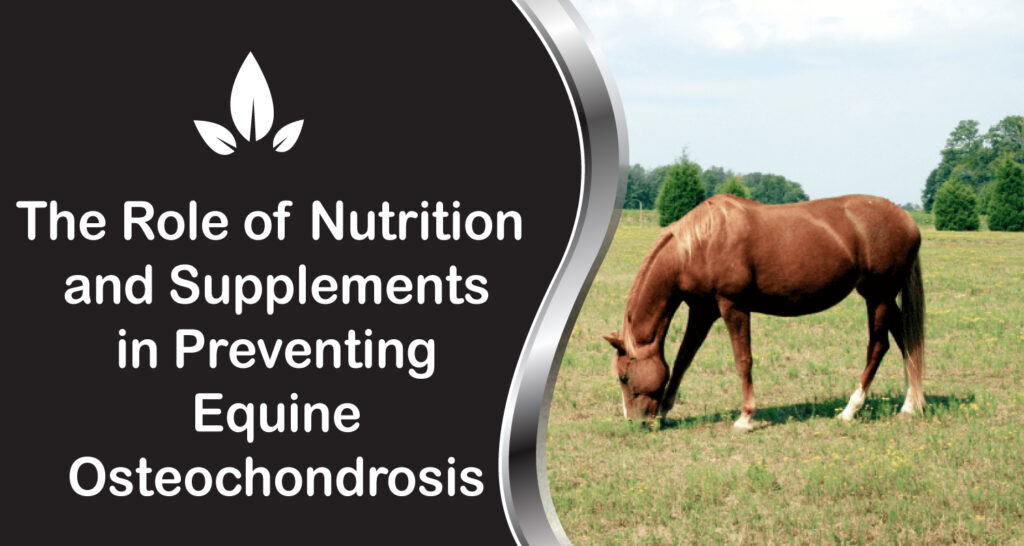Equine health is influenced by many factors, but nutrition plays a particularly important role in supporting proper growth and development. Among young horses, one condition that has been studied closely is horse osteochondrosis, a developmental disorder that can affect cartilage and bone formation in growing joints. While genetics, management, and exercise contribute to the condition, feeding practices and nutritional balance are often highlighted as key areas of consideration.
Understanding the significance of diet and supplements on the development of the joints can help horse owners, breeders, and trainers in their decision-making in selecting fitting decisions that contribute to healthy development and final soundness.
What is Equine Osteochondrosis?
Horse osteochondrosis is an orthopedic developmental disorder in which cartilage and bone in joints fail to form normally. In other horses, small pieces of cartilage do actually come loose, a condition commonly referred to as osteochondritis dissecans (OCD). The precise mechanisms are multifactorial of a complex nature with genetic susceptibility, accelerated growth rates, and mechanical stress being highly significant factors. Nutrition has also been recognized as a cause, particularly when diets are nutritionally unbalanced in respect to energy, protein, vitamins, and minerals.
The Function of Nutrition in Growth and Joint Development
Horses, especially at their growth phase, must be served extremely controlled diets. Excess energy, in the form of excess grain feeding, could result in growth at a pace the developing joints cannot keep up with. Conversely, improper or unbalanced nutrition could limit access to such building materials required for bone and cartilage development.
It is most often these bulk nutrients that are in question:
Protein and Amino Acids: Adequate protein sustains tissue growth, but excess protein is not proven to cause horse osteochondrosis. More significant is the relationship between essential amino acids, such as lysine, in collagen synthesis.
Minerals: Of specific interest are calcium, phosphorus, magnesium, copper, and zinc. Calcium and phosphorus imbalances or trace mineral deficiency of copper has been associated with joint development problems.
Vitamins: Vitamin A, D, and E are involved in skeletal health. Deficiency and excess impact bone metabolism.
Energy Intake: Foods resulting in too fast growth or weight gain have the potential to cause excessive mechanical loading on developing joints.
Counterbalanced to explosive weight gain, a less extreme growth rate is widely believed to be important in avoiding growing issues.
Benefits of Horse Joint Supplements
In addition to well-formulated feed, the majority of owners supplement their young horse with optiwize horse joint supplement. While no supplement can guarantee success, certain ingredients have been utilized for decades to encourage joints and cartilage.
Some of the most discussed supplement components include:
Collagen and Peptides: Collagen is a major cartilage structural protein. Supplemental collagen is often a constituent of joint supplements used to support the health of the cartilage.
Hyaluronic Acid: Due to its lubricating quality for joints, hyaluronic acid can be a component of formulas designed for horses that are in training or development.
Glucosamine and Chondroitin Sulfate: Both compounds naturally occur in cartilage and are used widely as components of horse joint supplements.
Trace Minerals: Since they play such a vital role in bone formation, copper and zinc are commonly included together in supplement mixes.
When evaluating a horse joint supplement, regard should be taken for the overall nutritional adequacy of the horse’s diet, quality of ingredients, and the particular needs of the horse by age, growth phase, and level of work.
Management Factors That Work Alongside Nutrition
While diet is part of the solution, it is only one component of the complex image of equine growth and joint development. Technique of management comes into play as well, and these are:
Exercise: Progressive exercise is necessary to bone remodeling and joint maintenance. High-impact or over-repetition of exercise in early life can put more stress on forming joints.
Body Condition Monitoring: Keeping young horses at a healthy weight will reduce stress on developing limbs.
Breeding Practice: While horse osteochondrosis does involve a genetic component, good breeding practice is part of the prevention plan too.
Combine good nutrition with good management methods to develop an even better method of supporting joint development in young horses.
Practical Tips for Owners and Breeders
For young horse breeding owners, here is an effective strategy for growth:
Work with a Veterinarian or Nutritionist: Consultation with professionals ensures diets that are well-balanced for energy, protein, and minerals.
Watch for Growth Rates: Choose consistent, moderate growth rather than accelerated weight gain.
Balance Concentrates and Forage: Good quality forage must be the foundation of the diet with concentrates added as necessary to supplement nutritional deficiencies.
Read Supplements Carefully: Select a horse joint supplement to supplement, rather than replace, nutrients already present in the diet.
Re-assess Periodically: The nutritional needs of horses change with age. Re-evaluation to ensure diets remains appropriate.
Final thoughts
Equine joint health, particularly in the context of horse osteochondrosis, is shaped by a combination of diet, exercise, management, and genetics. While there is no single way to eliminate the risk of developmental conditions entirely, incorporating consistently well-balanced diets and considering supporting measures like a horse joint supplement can be part of an overall strategy for healthy, persistent development.
The owners also desire specialty feeds, such as OptiWize Collagen Plus, as part of a feeding regimen. Given carefully and under the guidance of experts, supplements may be incorporated into a healthy feeding regimen for developing horses’ long-term health.



